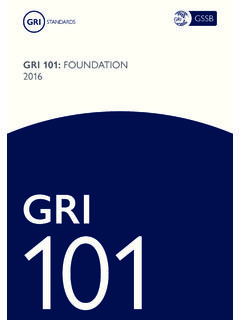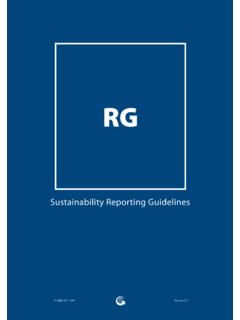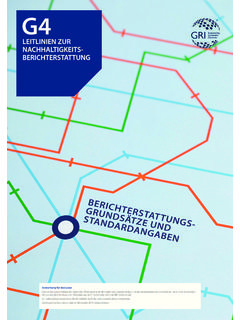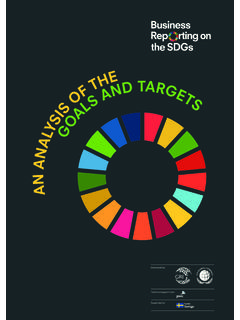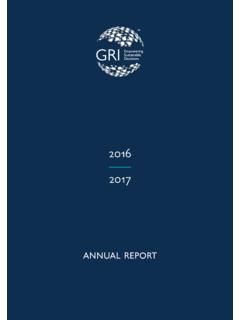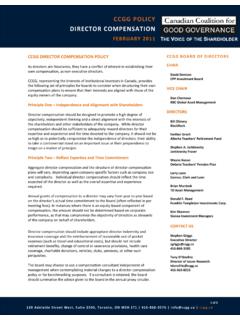Transcription of GRI 102: GENERAL DISCLOSURES 2016
1 GRI102 gri 102 : GENERAL DISCLOSURES 20162 gri 102 : GENERAL DISCLOSURES 2016 ContentsIntroduction 5 gri 102 : GENERAL DISCLOSURES 71. Organizational profile 7 Disclosure 102-1 Name of the organization 7 Disclosure 102-2 Activities, brands, products, and services 7 Disclosure 102-3 Location of headquarters 8 Disclosure 102-4 Location of operations 8 Disclosure 102-5 Ownership and legal form 8 Disclosure 102-6 Markets served 8 Disclosure 102-7 Scale of the organization 9 Disclosure 102-8 Information on employees and other workers 10 Disclosure 102-9 Supply chain 11 Disclosure 102-10 Significant changes to the organization and its supply chain 12 Disclosure 102-11 Precautionary Principle or approach 12 Disclosure 102-12 External initiatives 13 Disclosure 102-13 Membership of associations 132.
2 Strategy 14 Disclosure 102-14 Statement from senior decision-maker 14 Disclosure 102-15 Key impacts, risks, and opportunities 153. Ethics and integrity 16 Disclosure 102-16 Values, principles, standards, and norms of behavior 16 Disclosure 102-17 Mechanisms for advice and concerns about ethics 173 gri 102 : GENERAL DISCLOSURES 20164. Governance 18 Disclosure 102-18 Governance structure 18 Disclosure 102-19 Delegating authority 18 Disclosure 102-20 executive -level responsibility for economic, environmental, and social topics 19 Disclosure 102-21 Consulting stakeholders on economic, environmental, and social topics 19 Disclosure 102-22 Composition of the highest governance body and its committees 19 Disclosure 102-23 Chair of the highest governance body 20 Disclosure 102-24 Nominating and selecting the highest governance body 20 Disclosure 102-25 Conflicts of interest 21 Disclosure 102-26 Role of highest governance body in setting purpose, values.
3 And strategy 21 Disclosure 102-27 Collective knowledge of highest governance body 21 Disclosure 102-28 Evaluating the highest governance body s performance 22 Disclosure 102-29 Identifying and managing economic, environmental, and social impacts 22 Disclosure 102-30 Effectiveness of risk management processes 22 Disclosure 102-31 Review of economic, environmental, and social topics 23 Disclosure 102-32 Highest governance body s role in sustainability reporting 23 Disclosure 102-33 Communicating critical concerns 23 Disclosure 102-34 Nature and total number of critical concerns 24 Disclosure 102-35 Remuneration policies 25 Disclosure 102-36 Process for determining remuneration 26 Disclosure 102-37 Stakeholders involvement in remuneration 26 Disclosure 102-38 Annual total compensation ratio 27 Disclosure 102-39 Percentage increase in annual total compensation ratio 285.
4 Stakeholder engagement 29 Disclosure 102-40 List of stakeholder groups 29 Disclosure 102-41 Collective bargaining agreements 30 Disclosure 102-42 Identifying and selecting stakeholders 31 Disclosure 102-43 Approach to stakeholder engagement 31 Disclosure 102-44 Key topics and concerns raised 324 gri 102 : GENERAL DISCLOSURES 20166. Reporting practice 33 Disclosure 102-45 Entities included in the consolidated financial statements 33 Disclosure 102-46 Defining report content and topic Boundaries 34 Disclosure 102-47 List of material topics 35 Disclosure 102-48 Restatements of information 35 Disclosure 102-49 Changes in reporting 36 Disclosure 102-50 Reporting period 36 Disclosure 102-51 Date of most recent report 36 Disclosure 102-52 Reporting cycle 37 Disclosure 102-53 Contact point for questions regarding the report 37 Disclosure 102-54 Claims of reporting in accordance with the GRI Standards 37 Disclosure 102-55 GRI content index 38 Disclosure 102-56 External
5 Assurance 41 Glossary 43 References 48 ResponsibilityThis Standard is issued by the Global Sustainability Standards Board (GSSB). Any feedback on the GRI Standards can be submitted to for the consideration of the 102: GENERAL DISCLOSURES sets out reporting requirements on contextual information about an organization and its sustainability reporting practices. This Standard can be used by an organization of any size, type, sector or geographic referencesThis Standard is to be used together with the most recent versions of the following documents. GRI 101: Foundation GRI Standards GlossaryIn the text of this Standard, terms defined in the Glossary are dateThis Standard is effective for reports or other materials published on or after 1 July 2018.
6 Earlier adoption is encouraged. About this StandardNote: This document includes hyperlinks to other Standards. In most browsers, using ctrl + click will open external links in a new browser window. After clicking on a link, use alt + left arrow to return to the previous 102: GENERAL DISCLOSURES 2016A. Overview This Standard is part of the set of GRI Sustainability Reporting Standards (GRI Standards). These Standards are designed to be used by organizations to report about their impacts on the economy, the environment, and GRI Standards are structured as a set of interrelated, modular standards. The full set can be downloaded at There are three universal Standards that apply to every organization preparing a sustainability report: GRI 101: FoundationGRI 102: GENERAL DisclosuresGRI 103: Management Approach An organization then selects from the set of topic-specific GRI Standards for reporting on its material topics.
7 These Standards are organized into three series: 200 (Economic topics), 300 (Environmental topics) and 400 (Social topics). Each topic Standard includes DISCLOSURES specific to that topic, and is designed to be used together with GRI 103: Management Approach, which is used to report the management approach for the topic. B. Using the GRI Standards and making claims There are two basic approaches for using the GRI Standards. For each way of using the Standards there is a corresponding claim, or statement of use, which an organization is required to include in any published materials. 1. The GRI Standards can be used as a set to prepare a sustainability report that is in accordance with the Standards.
8 There are two options for preparing a report in accordance (Core or Comprehensive), depending on the extent of DISCLOSURES included in the report. An organization preparing a report in accordance with the GRI Standards uses this Standard, gri 102 : GENERAL DISCLOSURES , to report on contextual information about itself and its sustainability reporting practices. 2. Selected GRI Standards, or parts of their content, can also be used to report specific information, without preparing a report in accordance with the Standards. Any published materials that use the GRI Standards in this way are to include a GRI-referenced claim. IntroductionGRI 101: Foundation is the starting point for using the GRI Standards.
9 It has essential information on how to use and reference the Standards. See Section 3 of GRI 101: Foundation for more information on how to use the GRI Standards, and the specific claims that organizations are required to include in any published materials. GRI 103 gri 102 Topic-specificStandardsUniversal StandardsStarting point for using the GRI StandardsGRI 101 FoundationGeneral DisclosuresManagement ApproachTo report contextual information about an organizationTo report the management approach for each material topicSelect from these to report specific DISCLOSURES for each material topicGRI 300 EnvironmentalGRI 400 SocialGRI 200 EconomicFigure 1 Overview of the set of GRI Standards6 gri 102 : GENERAL DISCLOSURES 2016C.
10 Requirements, recommendations and guidance The GRI Standards include: Requirements. These are mandatory instructions. In the text, requirements are presented in bold font and indicated with the word shall . Requirements are to be read in the context of recommendations and guidance; however, an organization is not required to comply with recommendations or guidance in order to claim that a report has been prepared in accordance with the These are cases where a particular course of action is encouraged, but not required. In the text, the word should indicates a recommendation. Guidance. These sections include background information, explanations and examples to help organizations better understand the organization is required to comply with all applicable requirements in order to claim that its report has been prepared in accordance with the GRI Standards.

